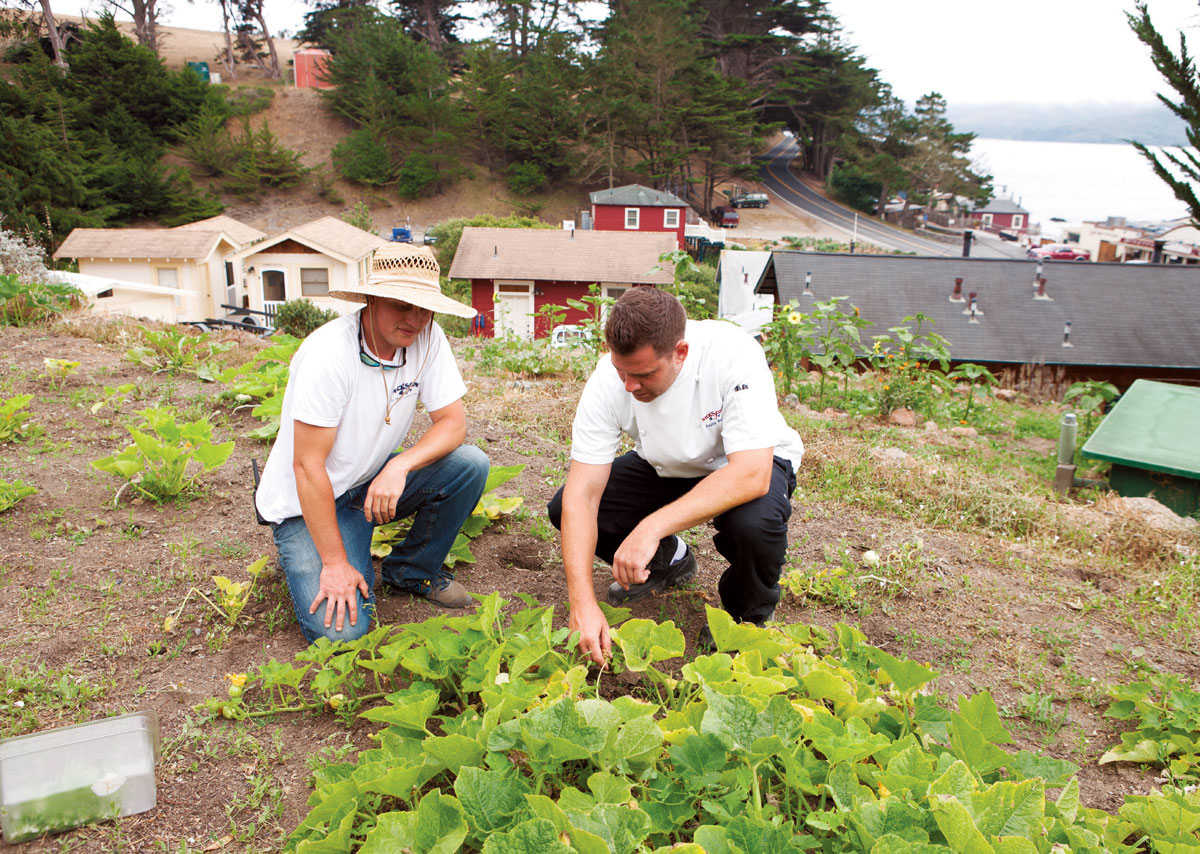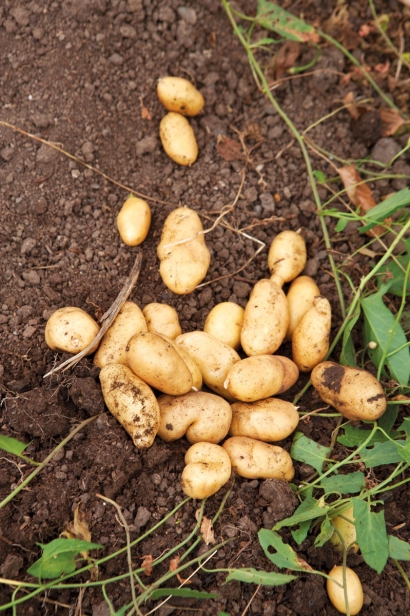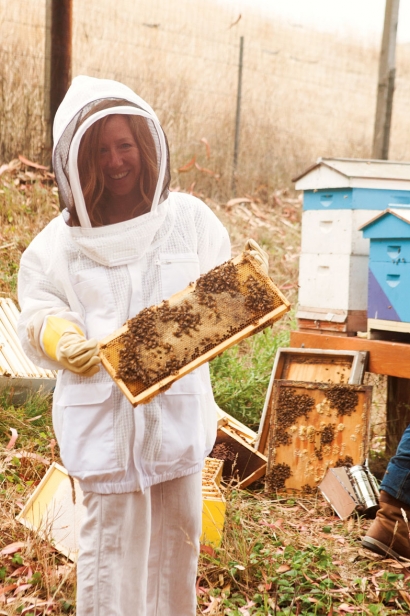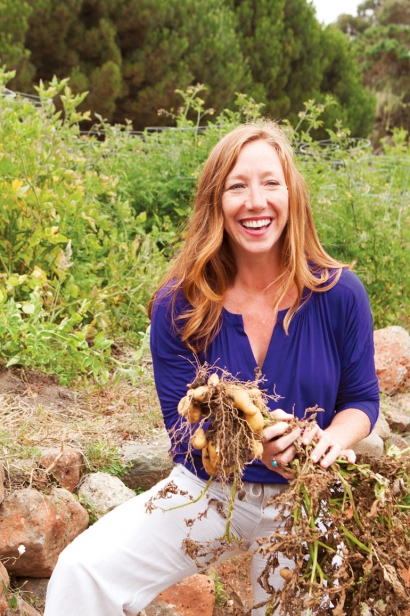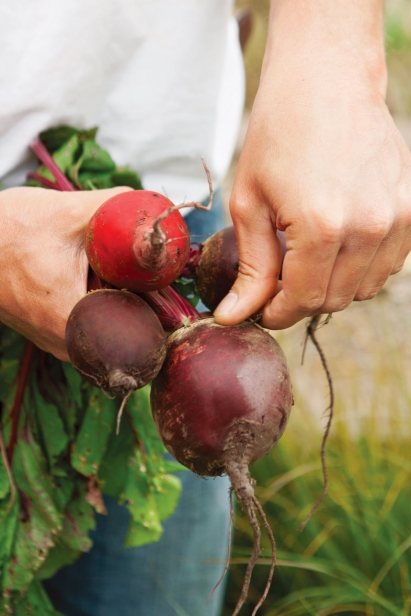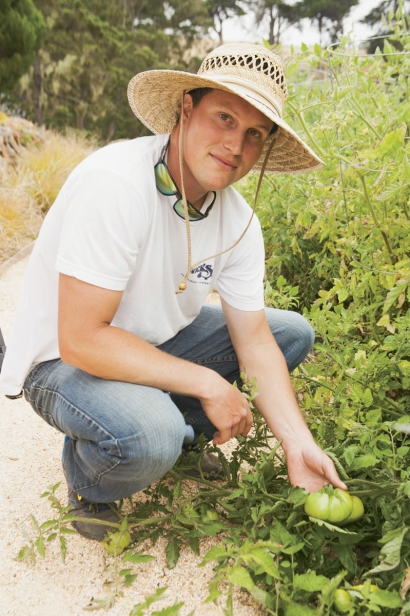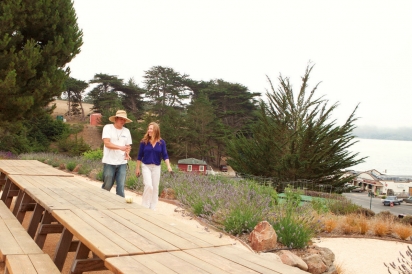The Croft at Nick's Cove
Imagine a row of small cottages perched above a remote and misty cove. They are simple, colorful structures, some sitting on stilts above the shallow sea. Vines wander along fence posts and up the cottage eves, and beds of nasturtium bloom bright against a backdrop of blue-grey bay.
To the east, picture rolling hills, lustrous green grazing pastures that rise to meet the white sky.
This might be a depiction of pastoral Scotland, but I am painting a picture of Nick’s Cove, the much-heralded resort and restaurant nestled into the eastern shoreline of Tomales Bay, just north of Marshall.
After years of hearing rave reviews of Nick’s Cove—“it is the place to go for an anniversary” or “you feel like you’re in a different world”—it was time for a visit. Now there were new rumors to spur my journey: the addition of a farm and kitchen garden on the hillside above the cottages. As a gardening teacher and fervent farm-to-table devotee, I am always eager to investigate when a restaurant has planted its own kitchen garden, and I wanted to see for myself how this new bayside garden grew.
Marshall is only an hour from the Marin–Sonoma Highway 101 corridor, but somewhere on the drive out, maybe as Marshall–Petaluma road narrows and curls down the west side of the foothills framing Tomales Bay, life at home, especially that to-do list, suddenly feels very far away. Thoughts are occupied by the fog formations on a distant ridge, the hawk circling the roadside field, a lone sailboat drifting toward the mouth of the bay.
By the time I pull into the parking spaces adjacent to Nick’s Cove’s restaurant and long dock stretching into the bay, I already feel I’ve been away for a long while. I get out and take a deep breath. The air is wet with a light mist, and smells of salt and kelp. All is quiet except for small waves lapping against the pilings of the pier.
I cross Highway 1 and follow a small path up the hill, past several more brightly colored guest cottages, toward the office of Dena Grunt, the general manager of Nick’s Cove, when I am waylaid by a small speckled fawn, not more than a week old and still wobbly on her legs. The fawn is blocking the pathway to Grunt’s door, so I wait a few moments until she climbs downhill to join her mother in the creek ravine below.
When I knock, Grunt greets me and we head toward the farm and garden, just a stone’s throw from her office. I had visions of a small collection of raised beds, but am making a mental adjustment as we walk through the gate into a terraced expanse, approximately two acres in total. After only a year, this garden is already a maze of pathways, vegetable and flower beds, fruit trees, native borders, various sitting areas, two bocce courts, a greenhouse, beehives and a chicken coop—make that chicken resort—home to 35 hens and one proud rooster named Slick Rick. Grunt and her colleagues have named this land The Croft, a word derived from the Scottish practice of “crofting,” a traditional form of land tenure and small-scale food production.
In 2012, when Grunt became general manager of Nick’s, she immediately began to dream of rehabilitating the large stretch of property just north of her office. The land had, at one time, been a garden, but was overgrown with wild grasses and thistles, the beds and pathways impossible to discern. But the space offers a breathtaking view of the entire resort, with the bay and Point Reyes wilderness beyond.
“I thought to myself, ‘This is a property that should be enjoyed. There is not a property like this anywhere,’” Grunt says as we stand on the broad uppermost terrace, where she envisions weddings and other festive farm-to-table dinners in the near future. We turn to soak up the outlook, and the sun breaks through the clouds, creating silver streaks across the bay. I have to agree: The view is stunning.
In January 2013 Grunt hired local Master Gardener and farmer Ross Barlow to help manifest her vision. Although Barlow is young, he has a lifetime of experience with sustainable farming practices, and she says she knew immediately that he was the right person for the job.
“I can be very demanding of him,” says Grunt, smiling, “Just because I have so many new ideas. I come up with an idea, and Ross is so great, he somehow makes it happen.” At that point Barlow wanders out from the greenhouse to come speak with us. He does strike me as young, but when I hear his history I understand his expertise and magic touch. Barlow attended the Summerfield Waldorf School in Santa Rosa, which has one of the most successful school farms and integrated gardening curricula in the country. He was raised practicing organic farming, including permaculture and biodynamic techniques.
Like the students I teach at the Novato Charter School, Barlow has been turning compost and amending soil for as long as he has been reading and writing.
“His specialty is compost teas,” Grunt tells me. “He’s like a mad scientist with the compost teas he creates for the garden!”
Indeed, the garden is remarkably robust and established after just a year, the vegetable and cut flower beds waist-high and overflowing.
We meander down a crushed-stone pathway, past the bocce courts and into the greenhouse where rows of microgreen starts await planting. I hear a hum and Barlow guides us to the corner where one of his aerator pumps is working away on a large barrel of deep brown compost tea.
“It’s the tea that makes the difference,” he says. “Everything is taking off.”
I ask him what other amendments he feeds the soil, and get a response that is obvious in retrospect.
“Well, we need to clean our beaches,” says Barlow. “So we collect the seaweed and decaying jellyfish that wash ashore. We use them in our compost. Also the eel grass that washes up and rots, we collect that and bury it.”
The Tomales shoreline is a treasure trove of rich organic matter, and it is a two-minute walk from his compost piles. Pt. Reyes Compost Co.’s special mixes—Bob’s Best, Double Duty, Mary Jane’s Blend—round out the buffet of amendments.
Increasingly, Nick’s Cove Executive Chef Austin Perkins finds his way through the garden gate as he designs his menus.
“Last year, when we had just started the garden, he would pull from The Croft in small ways to enrich and showcase our dishes,” Grunt tells me. “For instance, our parsley has an incredible full-bodied flavor that makes dishes shine. Or we used our lavender and made a syrup for cocktails.”
Now that the garden is in full swing, producing more than 50 pounds of mixed lettuces and 40 pounds of kale per week, the produce plays a more central role. This fall, Perkins will have an abundance of carrots, tomatoes, broccoli, cauliflower, Brussels sprouts, beets, pumpkins, squash, mustard greens, leeks, herbs and…you name it, to harvest for his kitchen palette.
The four beehives on the hill are thriving and have already offered a first harvest of honey, some of which made its way onto the menu in a grilled aprium (a plum and apricot cross) salad. Farm-fresh eggs are showcased on the in-room breakfast plates delivered to resort guests each morning.
“Soon guests will have the option to have their breakfast right here,” Grunt says, standing on one of the lower terraces and exuding excitement. “They can let us know they’d like to have breakfast in the garden and we will bring them their food here so they can sit in the morning and enjoy this view.”
Barlow points to a row of cypress above the harbor just below the garden, which provides wind protection, both for resort guests and for his plants. He tells me that he has been pleasantly surprised by the microclimate in the cove, which is noticeably more protected and temperate than other parts of Tomales Bay.
If all goes as Grunt and Barlow plan, not only resort and restaurant guests will enjoy the farm and garden but local school groups will soon visit as well.
“We would love to have students come to learn about our farming practices, then visit the kitchen, see the food as it is prepared, and taste it, to bring the lesson full circle,” says Grunt, herself the mother of a school-age son.
“We do want The Croft and Nick’s Cove to be a model of sustainable gardening and restaurant practices,” Grunt says, and, as if on cue, the sun moves from behind a cloud to showcase the healthy rows of deep green leaves in a nearby lettuce bed.
With the bounty of the sea out one door and the bounty of the land out the other, Nick’s Cove is perfectly placed to embody the ideals of local sourcing.


